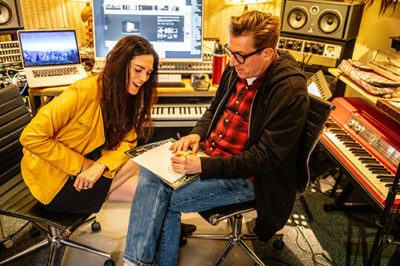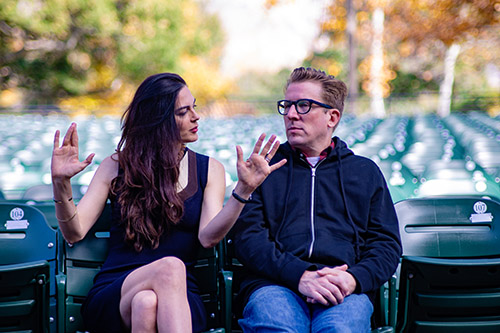ARTS SCENE | By Linda Harmon
‘Nightingale & the Tower’ Coming May 18-19
 Is our fascination with technology weakening our sense of empathy and our capability for human expression? Can the arts address and moderate the role technology plays in our society and in the lives of our youth? These questions spurred Rebecca Comerford, Artistic Director of the Ojai Youth Opera (OYO), to co-create the new opera,“Nightingale and the Tower.”
Is our fascination with technology weakening our sense of empathy and our capability for human expression? Can the arts address and moderate the role technology plays in our society and in the lives of our youth? These questions spurred Rebecca Comerford, Artistic Director of the Ojai Youth Opera (OYO), to co-create the new opera,“Nightingale and the Tower.”
“Our mission is to awaken the authentic expression of humanity and keep it alive,” said Comerford, who commissioned groundbreaking classical composer Jason Treuting and Grammy award-winning Wilco keyboardist Mikael Jorgensen to co-create the opera, which will premiere in Libbey Bowl May 18 and 19.
The opera’s main character is a young boy, Teo, who is being raised by his single mother in a technologically-controlled town on the edge of a forest. One day he finds a damaged nightingale and begins a journey to save her, encountering an “empress in a forbidden, mythical tower.” The operatic drama unfolds: will Teo find a way to heal her and restore balance or will darker forces engulf them?
This tale is told from a child’s perspective. Children from Ojai Youth Opera are playing the primary roles with featured guest professionals in the supporting roles. Adult cast members include Contralto Nicole Mitchell, who will be debuting at the Metropolitan Opera this fall; Coloratura Soprano Sequina DuBose; Baritone Andrew Petracca; and OYO founders Comerford and Julija Zonic.
“This opera is a story about the delicate balance children must tread between technology and the environment,” said Comerford. “Set in a dystopian world that no longer seeks value in nature or its wild and beautiful imperfection … the hero will be someone who understands the importance of nature.”
“This subject matter really resonates with me,” said Treuting. “As a parent, it is exciting and terrifying to watch them learn to make their way through this world. I am conscious of my job to guide them towards the larger truths when I can, and allow them to learn for themselves when they need. And this question of technology — both the exciting things it uncovers and the scary things it unleashes — seems to be on the forefront of every parent’s mind right now.”
The statistics of time spent on media is staggering. A recent study from Common Sense Media has found that on average, teens spend nine hours a day using media and those between the ages of 8 and 12 spend six.
“The ideas for this opera have been simmering for a while,” said Jorgensen. “As a parent, navigating the role technology plays in the lives of my children is an ongoing experiment. We have identified that keeping a balance of screen time and physical play is important but simultaneously elusive. How much is too much? How much is not enough? We acknowledge that technology is a part of our experience as human beings and a reductive dogmatic rejection of its role in our lives is not realistic. Screens are one of the ways that we experience and engage with the world beyond our day-to-day community, and it feels somewhat irresponsible to categorically deem it a bad influence. This is not to say that it is not without its own dubious set of trade-offs, there are many … It’s this intersection of screen versus physical that I find perplexing and mysterious, and it’s great material to write an opera about.”
Musically speaking, the opera uses the sonic texturing of synthesizers, ambient sounds, children’s chorus, opera soloists, percussion, and chamber orchestra, all performing real-time sound manipulations with acoustic instruments and classical voicings.
“Each performance will be from a set score,” said Comerford, “but each will also feature something original. Mikael will be filtering the performance through all his electrical equipment in real time, and that will change it.”
In a way, this opera brings improvisation back into post-modern opera.
“We have this very neoclassical score with sweeping melodic lyrical lines but, with Jason’s background as a percussionist, it also has polyrhythms and meters you might not always hear in opera,” said Comerford, adding that Jorgensen’s contributions, “digitalizing and looping the performances,” mirror the story and build another bridge between technology and nature.
“In the beginning of the art form, with the arias there was a little room for improvisation, but as you moved ahead into the era like Puccini’s, the composer was king. You followed everything,” said Comerford. “In our opera, yes, we have this very solid compositional score but then, what we do with it, taking samples in real time and sending them through multiple computer processing devices, transforms it. That is the exciting, pioneering, otherworldly part of it.”
Every performance will be delivered a little differently every night.
“Whenever a collaboration like this unfolds, I find it essential to bring strong ideas to the table but to be open to where it takes you,” said Treuting. “The music will take a live score and process it in real time. That will lead places we haven’t thought of yet and I am eager to be surprised!”
“I am so grateful to have these brilliant musicians that are complementary to each other,” said Comerford. “Jason with his influence of performance and being a part of a percussion ensemble for many years. The whole world is his playground, in the way of John Cage, but he also has a strong sense of lyricism. And then Mikael is someone who really embraces technology. I’m somewhat a purist and our collaboration is this sort of unlocking. We had a lot of philosophical discussions. I wanted to tell a cautionary tale about how this technology is shaping us, but Mikael, who embraces it, felt it is also a tool for progress and wanted to ask, ‘What is our responsibility to use it to unlock our full potential?’ So the opera became about empowering for the good and unlocking our full creative potential.”
Treuting says he has spent his career “learning about collaboration and pushing myself in different directions … Here I get to collaborate with Rebecca, an old friend that I have known since college, and my partner Beth Meyers, who is collaborating on the score with me, and make new artistic connections with Mikael and all the wonderful folks that the OYO brings together.”
According to Comerford, the three wanted to do something together for years. Meyers, another accomplished Princeton artist, will be doing the arranging and conducting for the score.
“We’re still in the pre-production phase so there is still a giant pile of learning to be done before the house lights go down in May,” said Jorgensen. “In the meantime I’m enjoying my ‘new-to-me’ role as production designer. It will enable me to make sure the show looks incredible, and most importantly, sounds amazing.”
Comerford’s founding of Ojai Youth Opera has been a long road traveled in a relatively short time. She lived in New York and worked for the Metropolitan Opera Guild before her move to Ojai.
“As a Guild we did outreach performances in all five boroughs, performing select scenes and sometimes adapted operas for children,” said Comerford. “We’d have them sing a chorus and it was so interactive, so gratifying. It almost didn’t matter what language we sang in; Italian, French, German, they understood. I would sing ‘Carmen’ and they could tell me the whole plot synopsis and scenario.”
Comerford says her two years doing opera outreach summer camps for the Brooklyn Conservatory of Music was her “first experiment” with 7-18 year olds. At the opera workshops she used an adapted English-version of Rossini ’s “La Cenerentola,” (“Cinderella”) and introduced guest artists from the Met. “It was just super joyful.”
She brought all that joy to Ojai. When she met Smitty West in 2012, she asked if there might be an interest in a youth opera camp here. In response, West introduced her to voice teacher Zonic. “We met and it was the meeting of two like-minded individuals,” said Comerford. ”She grew up singing classical opera and opera was her first love.”
Comerford, West, and Zonic began OYO summer camps that June. Those first two successful and well-attended camps led to interest in an ongoing program and they established a nonprofit in 2015.
“It became clear to me the long term goal was a resident company,” said Comerford, who saw a demand for more than the summer camps could provide. “A resident company could take this idea of making opera accessible and relevant to children, and relevant to all of us in a new real way.”
Ojai Youth Opera now has a 10-member board including Alice Asquith Dedadelsen, who Comerford learned had been an assistant to Placido Domingo and diction coach for the Los Angeles Opera. She is joined by Rhonda Fehr, Tessie Goddard, Dr. Tony Hirsch, Olga Jones, Nusa Maal, Jen Miller and Sharon West.
OYO’s 2017 sold-out collaborative production with Opera Santa Barbara of the internationally renowned “Brundibár” met with critical acclaim. The children’s opera, composed in 1938 by Jewish Czech composer Hans Kraśa, told the story during Hitler’s incarceration and extermination of the Jewish people. The opera was followed with an educational outreach tour that addressed themes of bullying and tolerance throughout Ventura, Los Angeles, and Santa Barbara county’s unified school districts. The Ojai Youth Opera reached tens of thousands of public school children, ages 5th grade to high school juniors.
“As an organization we chose material that has a socially conscious message,” said Comerford. “We want to create material that can shape hearts and minds to further examine our path as humans. These stories need to be told, things we are grappling with daily. And that’s how I feel about ‘Nightingale and the Tower.’”
With this new opera Comerford hopes to go a step further with the company, its music, and its outreach. She has planned a series of “pop-ups” including a performance by Ojai-based Andrea Brook and her earth harp, the “Sonic Butterfly,” interactive educational workshops in Libbey Park, and several school science workshops using schematics to map sound waves.
“I feel we are so lucky to have all these connections,” said Comerford. “There are even plans to have it filmed by director and filmmaker Andre Hormann.”
The opera is scheduled to be broadcast by German public broadcasting, and a short film is in the works. OYO will put Ojai youth on the world stage and be one tool to provoke, educate and steer the arts and humanity in a more human direction. ≈OQ≈


Leave A Comment